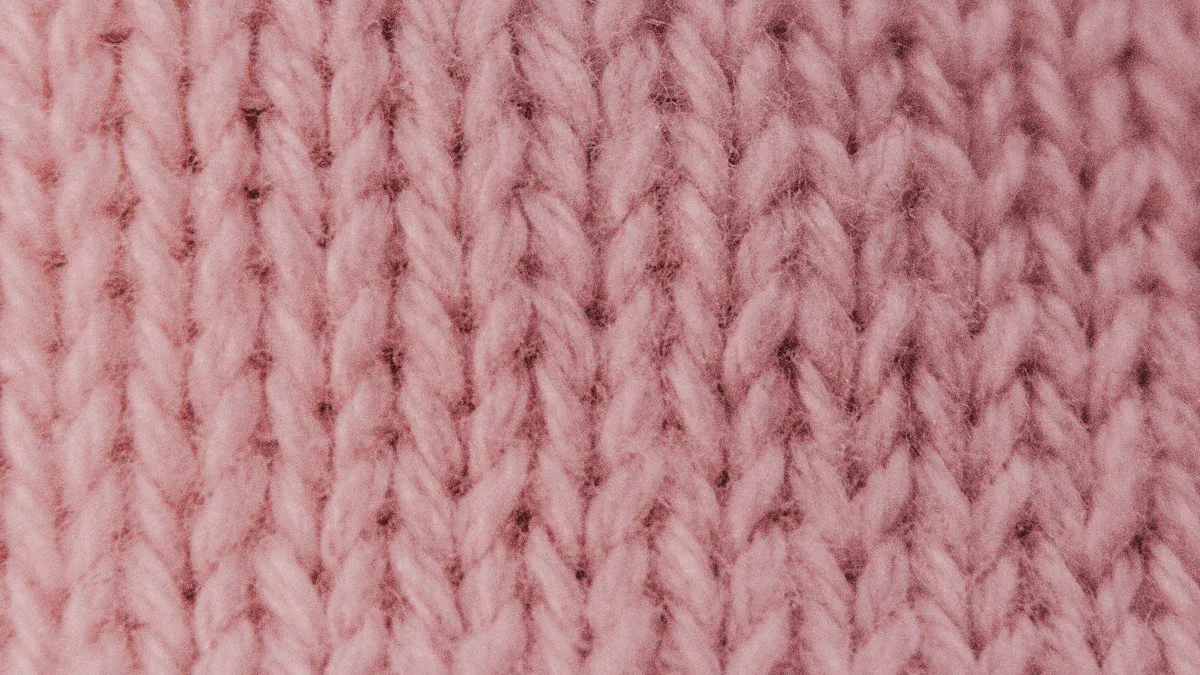
Comfort and style are important in every season, so choosing knit fabrics starts with understanding fabric weight, fiber content, and your local weather conditions. Many people find choosing knit fabrics challenging because of a few common issues:
You need to know how different knit fabrics behave, especially their stretch and how well they return to their original shape.
Fabric quality can vary, so the same pattern might fit differently depending on the fabric you choose.
Problems like pilling and shrinking can damage your clothes if you don’t care for them properly.
Matching the right fabric type to your project requires practice and attention.
By mastering the essentials of choosing knit fabrics, you can make smarter decisions for comfort and style all year round.
Key Takeaways
Pick knit fabrics by looking at weight, fiber type, and your local weather. This helps you stay comfy all year.
Lightweight knits help you stay cool in summer. Midweight knits are good for spring and fall. Heavyweight knits keep you warm in winter.
Natural fibers like cotton and wool let air in and feel soft. Synthetic fibers make fabric strong and stretchy, but they can hold in heat.
Blended fabrics mix natural and synthetic fibers. This makes them comfy, strong, and easy to care for.
You can layer different knit weights and fabrics. This helps you change your outfit for the weather or what you are doing.
Choosing Knit Fabrics
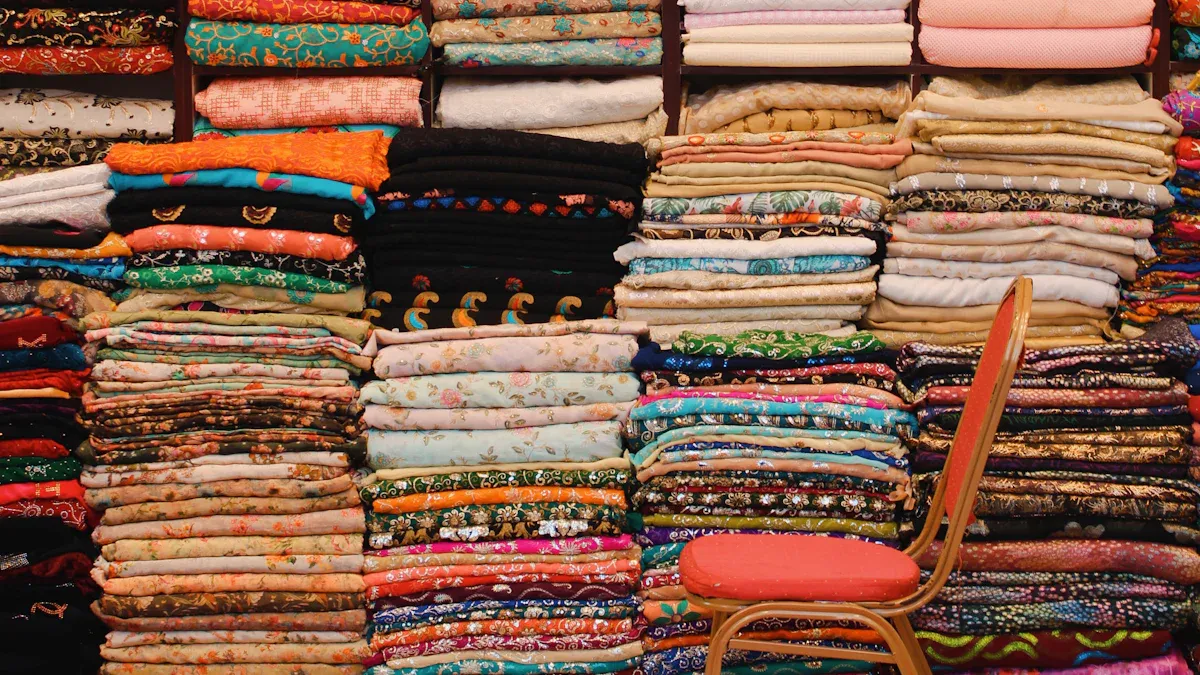
What Are Knit Fabrics
When you start choosing knit fabrics, you notice their unique structure. Knit fabrics are made by looping yarns together, which creates a soft and stretchy material. You can find two main types: weft knits, where loops run side to side, and warp knits, where loops run up and down. Single knits, like jersey, feel light and may curl at the edges. Double knits, such as interlock, have two layers of loops, making them thicker and more stable. Circular knitting machines can make seamless tubes, which add even more comfort and stretch. The way these loops connect gives knit fabrics their famous flexibility and softness.
Knit vs Woven
Choosing knit fabrics often means comparing them to woven fabrics. Knits use loops, while wovens use yarns that cross at right angles. This difference changes how the fabrics feel and behave. Knits stretch easily in all directions and let air flow through, so they feel cool and comfortable. Wovens do not stretch much and feel firmer. Knits resist wrinkles and their edges curl instead of fraying. You need special stitches to sew knits because of their stretch. Wovens, on the other hand, need edge finishing to stop fraying and use regular sewing stitches.
Feature | Knit Fabrics | Woven Fabrics |
|---|---|---|
Stretch | High | Low |
Breathability | High | Moderate |
Edge Behavior | Curl | Fray |
Sewing Needs | Stretch stitches | Standard stitches |
Year-Round Benefits
Choosing knit fabrics gives you comfort in every season. These fabrics breathe well, so you stay cool in summer and warm in winter. Their stretch lets your clothes move with you, making them perfect for active days or relaxing at home. You find knits in everything from T-shirts to sweaters, showing their versatility. Ribbed knits help keep your body temperature steady, and most knits keep their shape and softness after many washes. When you choose knit fabrics, you get clothing that feels good, looks good, and works for any time of year.
Fabric Weight and Seasons
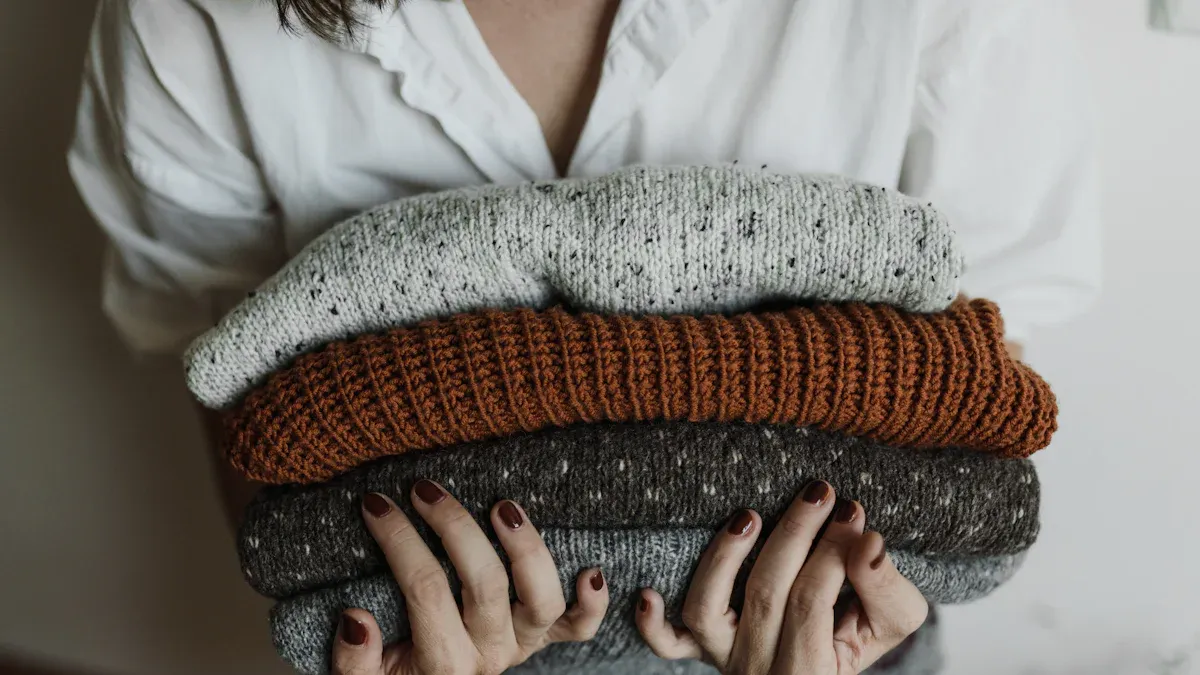
Picking the right knit fabric weight helps you feel good all year. Fabric weight means how heavy or light a fabric is. You measure it in grams per square meter (GSM). Lighter fabrics let air move through, so you stay cool. Heavier fabrics keep air in, so you stay warm. The thickness and how the knit is made also change how much heat the fabric keeps or lets out.
GSM Range | Typical Applications | |
|---|---|---|
Lightweight | Less than 200 | Clothing, decorative purposes, medical and industrial uses |
Medium-weight | 200 to 400 | Casual clothing, upholstery, outdoor and performance fabrics |
Heavyweight | More than 400 | Upholstery, industrial and outdoor uses, technical applications |
Tip: Look for the GSM on the label or ask the seller. This number helps you pick the best fabric for each season.
Lightweight Knits
Lightweight knits are soft and thin. They let air pass, so you stay cool and dry. These fabrics are best for hot days or as a first layer. You can use them for summer tops, dresses, or sports clothes. Lightweight knits are usually under 200 GSM.
Some popular lightweight knits are:
Typical GSM | Suitability for Warm Climates | |
|---|---|---|
~175 | Breathable, stretchy, firm enough for leggings; good for warm weather | |
Bamboo Rayon Knits | ~250 | Lightweight with good drape; suitable for warm climates but more flowy |
Merino Wool (Lightweight) | 150-190 | Highly breathable, moisture-wicking, quick-drying; ideal for summer and active wear |
Merino wool in a lightweight knit keeps you cool and dry. Cotton/spandex blends stretch and breathe, so they work well for T-shirts and leggings. Bamboo rayon feels soft and hangs nicely, so it is great for loose tops.
Note: Some lightweight knits with spandex might feel lighter than their GSM. This makes them extra comfy in hot weather.
Midweight Knits
Midweight knits give you both warmth and breathability. These fabrics are good for spring and fall, when the weather changes a lot. You can use them for long-sleeve shirts, light sweaters, dresses, and cardigans. Midweight knits are between 200 and 400 GSM.
Here are some common midweight knit fabrics and how they work:
Fabric Type | Popularity for Transitional Seasons | Warmth Level | Breathability | Additional Features/Notes |
|---|---|---|---|---|
Denim | Popular | Moderate warmth | Moderate to low | Durable, classic style; can be heavy and stiff; lacks flexibility and stretch |
Canvas | Popular | Moderate warmth | Moderate to low | Durable and abrasion-resistant; rigid feel; absorbs moisture; limited stretch |
Twill Blends | Popular | Moderate warmth | Moderate | More flexible than canvas; lacks stretch and water resistance |
AT Cloth (Technical Fabric) | Popular | Lightweight warmth | High | Stronger than denim, lighter weight; added stretch; water-repellent; breathable and flexible |
Spectrum Fabric (Warp-knit technical) | Emerging option | Moderate warmth | High | Combines softness and flexibility of knits with woven resilience; 4-way stretch; moisture-wicking; water-repellent |
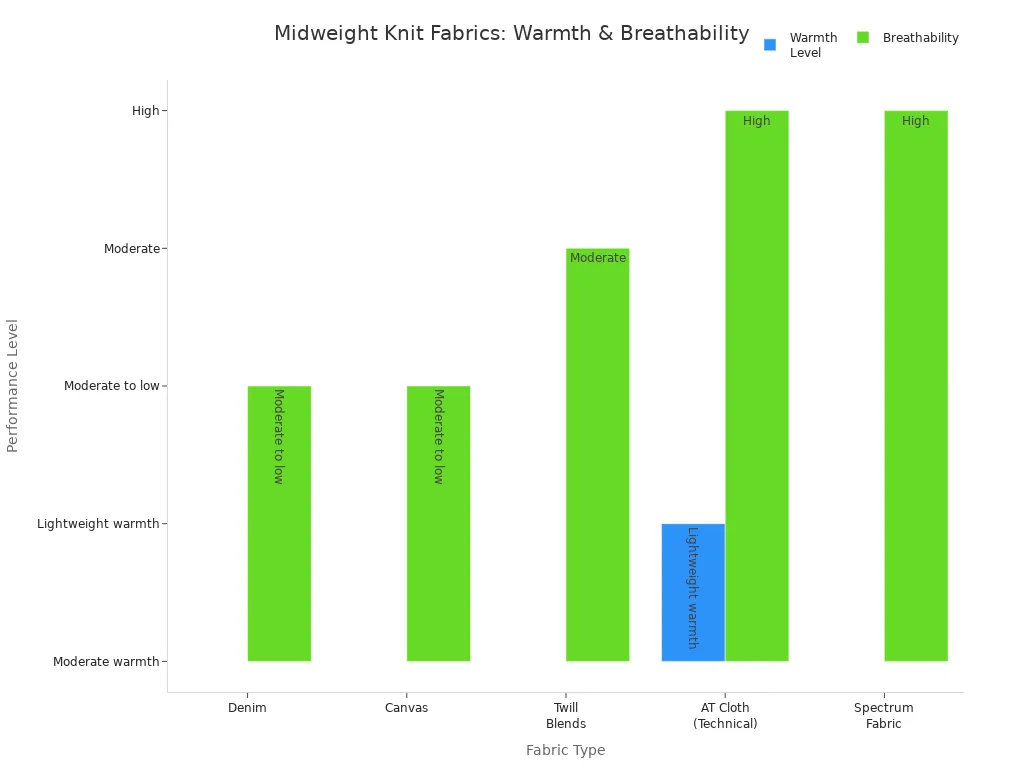
Jersey knits are also in this group. They feel soft and bend easily, so they are good for layering. Technical knits, like AT Cloth and Spectrum, stretch and help control sweat, which is good for outdoor fun.
Tip: Pick midweight knits for layering. You can add or take off layers as the weather changes.
Heavyweight Knits
Heavyweight knits are thick and strong. They trap air, so you stay warm in cold weather. These fabrics are best for winter clothes, like sweaters, hats, scarves, and jackets. Heavyweight knits are over 400 GSM.
You can find heavyweight knits in:
Wool sweaters and hats: Wool holds heat and moves sweat away, so you stay warm and dry.
Fleece jackets and thermal tops: Fleece is made from polyester. It feels soft and fluffy. It keeps heat in and dries fast.
Heavy denim jeans and twill chinos: These fabrics are warm and tough for winter.
Heavyweight knits keep you warm by holding air inside. This air blocks the cold. Wool and fleece keep you warm even if they get wet. You can wear heavyweight knits outside or when you need to be warm inside.
Note: Wear heavyweight knits with lighter layers. This helps you stay comfortable in winter.
In summary:
Lightweight knits help you stay cool and dry in summer.
Midweight knits are good for spring and fall. They give you warmth and let air in.
Heavyweight knits keep you warm and cozy in winter.
Knowing about fabric weight helps you choose the right knit for each season. You can feel comfortable and look good all year by matching fabric weight to what you need.
Fiber Types
When you pick knit fabrics, fiber type is important. It matters just as much as fabric weight. Each fiber gives your clothes special qualities. These qualities change how comfy, easy to care for, and useful your clothes are in every season.
Natural Fibers
Natural fibers come from plants or animals. Some examples are cotton, wool, linen, and silk. These fabrics feel soft and let your skin breathe. Cotton and linen let air move through easily. This makes them great for hot weather. Wool, like Merino wool, keeps you warm in winter. It also lets your skin breathe. Silk feels smooth and light. It makes clothes feel fancy.
Fabric | Breathability | Moisture-Wicking | Water Absorption | Insulation & Notes |
|---|---|---|---|---|
Cotton | Excellent | Poor | Very High | Breathable, absorbs sweat, not ideal for heavy activity |
Linen | Excellent | Poor | High | Very cool, wrinkles easily, not great for sweat |
Wool (Merino) | Excellent | Good | Moderate | Warm, wicks moisture, stays warm when wet, odor-resistant |
Silk | Decent | Good | Moderate | Soft, breathable, less insulating than wool |
Wool is best for warmth and keeping you dry. Cotton and linen are best for letting air in, but they soak up sweat instead of moving it away.
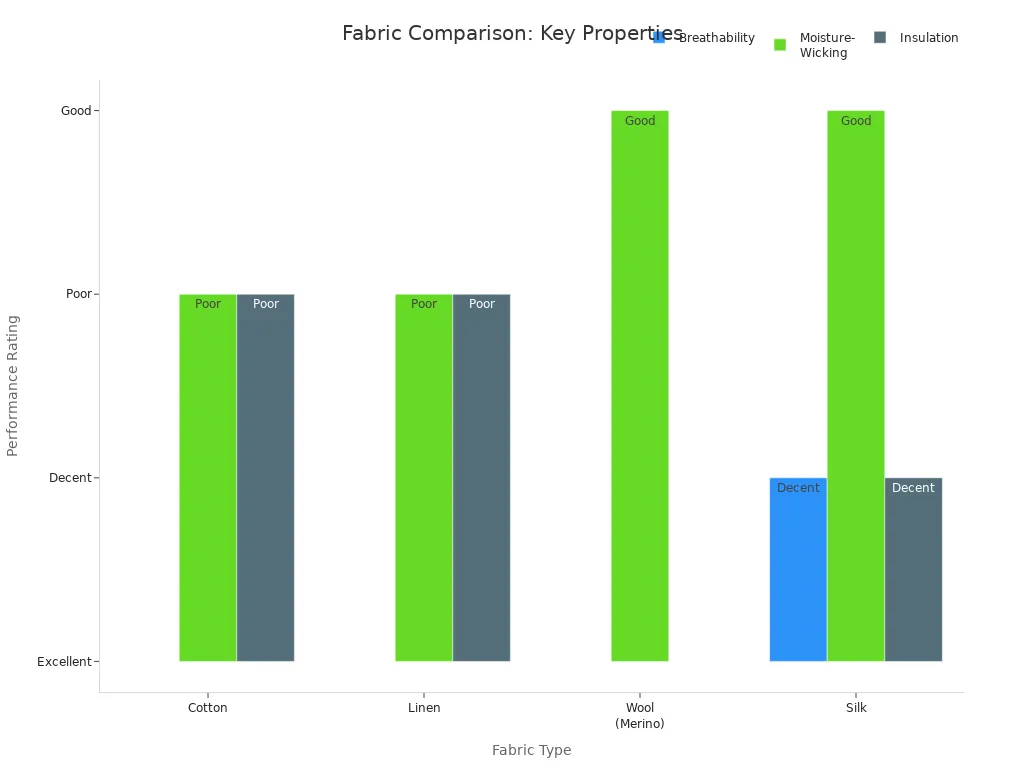
Synthetic Fibers
Synthetic fibers are made in factories. Polyester and nylon are two common types. These fibers make fabrics strong and stretchy. They are also easy to wash and care for. Polyester does not shrink or fade easily. It is good for sports clothes and cool weather. Nylon is tough and dries fast. But these fibers do not let air in as well as natural ones. You might feel hot or sweaty in them during summer.
Fiber | Advantages | Disadvantages |
|---|---|---|
Polyester | Durable, lightweight, resists shrinking and fading, easy to care for | Poor breathability, can feel sticky in heat, environmental concerns |
Nylon | Strong, flexible, dries fast, resists mildew | Not absorbent, can cause static, also has environmental impact |
Synthetic fibers are easy to clean and last a long time. But they can trap heat and sweat, so they may feel less comfy in hot weather.
Blends
Blends mix natural and synthetic fibers together. This gives you the good parts of both. For example, cotton-polyester blends feel soft and let air in. They also wrinkle less and last longer than pure cotton. Adding spandex to cotton or wool makes clothes stretchier and helps them keep their shape.
Natural fibers in blends help your clothes breathe and feel soft.
Synthetic fibers make clothes stronger, stretchier, and easier to care for.
Blends often handle sweat better and keep their shape after many washes.
Performance Aspect | Natural Fibers | Synthetic Fibers | Blended Fibers |
|---|---|---|---|
Lower | High | Balanced | |
Elasticity | Low | High | Moderate |
Heat Retention | High (wool) | Low | Moderate |
Breathability | High | Low | Moderate |
Moisture-wicking | Moderate | Low | High |
Care | Special care | Easy | Easier |
Eco Impact | Low | High | Varies |
Blended knits are comfy, strong, and easy to care for. They are a smart pick for wearing all year.
Spring Knits
Balancing Warmth and Breathability
Spring weather can change quickly. You might feel chilly in the morning and warm by the afternoon. When you choose knit fabrics for spring, you need to balance warmth and breathability. The right fabric keeps you comfortable all day.
Here are the key factors to consider:
Key Factor | Explanation |
|---|---|
Breathability | Lets air move through the fabric. You stay cool and dry without overheating. |
Warmth and Lightness | Gives you enough warmth for cool times but stays light for easy movement. |
Fabric Density and Weight | Helps you match the fabric to spring’s changing temperatures. |
Softness and Comfort | Feels gentle on your skin. You want comfort for clothes you wear close to your body. |
Fabric Blends | Mixes natural and synthetic fibers. This makes the fabric stronger and easier to care for. |
Performance Features | Moisture-wicking and stretch help you stay dry and move freely. |
Tip: Look for knits that feel soft and light but still keep you warm when needed. Fabrics with a bit of stretch will move with you and keep their shape.
Best Fabrics for Spring
You have many good choices for spring knits. Some fabrics work better than others because they let your skin breathe and keep you comfortable.
Open weave cotton mesh knits let air flow. Brands like Sunspel make these for spring and summer.
Loose knits from Portuguese Flannel feel light and work well in warmer weather.
Organic cotton knits from Flint and Tinder or Taylor Stitch offer comfort and good value.
Cotton knits and rayon knits both breathe well. They drape nicely and do not cling.
Sweater knits and sweatshirt fleece give you comfort and work for casual spring outfits.
Avoid Lycra blends for spring. They often cling and do not let your skin breathe.
Choose knits with good stretch and recovery. These fabrics fit close but do not feel tight.
Spring knits should help you feel fresh and cozy. Pick fabrics that match your style and the weather in your area.
Summer Knits
Staying Cool
When it gets hot in summer, you want to feel cool and comfy. The right knit fabrics help you stay cool. Lightweight knits are best because they are thin and light. They weigh less than four ounces for each yard. This makes them easy to wear in the heat. Air can move through these fabrics, so you feel the breeze. This helps your body stay cool.
Breathability is very important. Fabrics that let air move and pull sweat away help keep your body at a good temperature. Natural fibers like cotton and linen are great for summer. Cotton feels soft and soaks up sweat, so you stay dry. Linen has a loose weave that lets air in and keeps you cool. Both fabrics feel nice on your skin and do not stick to you.
Some knit types make hot days even more comfortable:
Rayon jersey knit is light, stretchy, and lets air in.
Mesh knit lets lots of air flow and dries fast, so it is good for sports.
Linen knits have open weaves for light cover and easy layering.
Tip: Pick knits with open weaves and natural fibers for the coolest feel.
Top Summer Fabrics
Experts in fashion and fabric suggest some knits for summer. These fabrics are soft, let air in, and help manage sweat. You can find them in many summer clothes, from casual to sporty.
Knit Fabric Type | Fiber Category | Key Characteristics | Typical Summer Usage |
|---|---|---|---|
Cotton Jersey | Natural fiber | Soft, breathable, stretchy | T-shirts, dresses, loungewear |
Bamboo Blend | Sustainable blend | Moisture-wicking, soft, eco-friendly | Tops, sleepwear, activewear |
Linen Knit | Natural fiber | Loose weave, cool, durable | Layering pieces, summer tops |
Rayon Jersey | Semi-synthetic fiber | Lightweight, silky, drapes well | Dresses, skirts, casual tops |
Mesh Knit | Synthetic/natural | Maximum airflow, quick-drying | Sportswear, outdoor wear |
Rib Knit | Natural/synthetic | Stretchy, breathable, holds shape | Tanks, fitted tees, summer vests |
You can also try eco-friendly choices like organic cotton and bamboo. These fabrics are soft and help you stay cool. Many summer knits come in light colors and fun textures. This adds style to your summer outfits. Pick fabrics that fit what you do and what feels best for you in the heat.
Fall Knits
Layering for Comfort
Fall brings cooler mornings and warmer afternoons. You need to stay comfortable as the temperature changes. Layering with knit fabrics helps you adjust throughout the day. Start with a soft, breathable base layer next to your skin. A lightweight knit top or tee works well for this. Add a middle layer, such as a cozy sweater or cardigan, for extra warmth. Finish with an outer layer like a denim jacket or a chunky knit vest.
Mixing textures creates a stylish look. Pair a smooth knit with a rugged denim jacket. This adds interest and keeps you comfortable. Try wearing tights under skirts or dresses. This keeps your legs warm without making you feel bulky. Use a belt to define your waist. This helps you avoid a bulky look when you wear several layers.
Keep your outfit simple. Three layers—base, middle, and outer—work best. Choose neutral or monochromatic colors. These colors make it easy to match your layers and highlight special pieces. Pick items that look good on their own. If you remove a layer, your outfit still looks complete. Balance your silhouette by mixing fitted and loose pieces. For example, wear a fitted top with a chunky cardigan.
Tip: Dress from lightest to heaviest. Start with thin knits inside and add thicker pieces outside. This lets you adjust your outfit as the weather changes.
Recommended Fall Fabrics
You want fabrics that keep you warm but let your skin breathe. Midweight knits work best for fall. Cotton blends, merino wool, and modal knits offer softness and warmth. Sweater knits and French terry give you comfort and flexibility. Ribbed knits hold their shape and add texture.
Fabric Type | Key Features | Best Uses |
|---|---|---|
Cotton Blend | Soft, breathable, easy care | Tees, cardigans |
Merino Wool | Warm, moisture-wicking | Sweaters, base layers |
Modal Knit | Smooth, drapes well | Tops, dresses |
French Terry | Soft loops, flexible | Sweatshirts, joggers |
Rib Knit | Stretchy, holds shape | Fitted tops, cuffs |
Choose these fabrics for your fall wardrobe. They help you layer with comfort and style as the season changes.
Winter Knits
Insulation and Warmth
You need knit fabrics that keep you warm when winter arrives. The best winter knits trap heat and help your body stay comfortable. Wool knits work well because they hold warmth and manage moisture. Wool fibers have tiny pockets that trap air. This air acts as a barrier against the cold. Heavyweight knits, which weigh more than 8 ounces per yard, feel thick and cozy. These fabrics keep you warm even on the coldest days.
Polyester-based fleece knits also help you stay warm. The brushed surface of fleece traps air, which adds insulation. Fleece resists wear and lasts a long time. Wool outperforms other fibers in insulation, but polyester fleece offers strong durability. Cotton knits do not insulate as well in winter. Cotton absorbs moisture and lets heat escape, so you may feel cold and damp.
The structure of the knit matters too. Dense, tightly knit fabrics hold in more heat. Looser knits let air pass through and may not keep you as warm. When you choose winter knits, look for thick, heavy fabrics made from wool or fleece. These choices give you the best insulation and comfort.
Tip: Choose heavyweight knits with a dense structure for the warmest winter wear.
Best Winter Fabrics
You have many options for winter knit fabrics, but some stand out for their warmth and comfort. Wool knits, especially Merino wool and boiled wool, work best for very cold weather. Merino wool feels soft and warm without adding bulk. You can wear it as a base layer to keep heat close to your body. Boiled wool is dense and felted, making it perfect for outerwear like coats and cardigans.
Other winter knits include:
Cashmere: Soft, lightweight, and very warm.
Fleece: Made from polyester, traps air, dries quickly, and resists abrasion.
Wool blends: Mix wool with synthetic fibers for added strength and easy care.
Silk: Thin but warm, good for layering under heavier knits.
Wool knits give you warmth, moisture control, and natural water resistance. These features make them the top choice for winter. If you want extra softness, try cashmere or Merino wool. For outer layers, boiled wool and fleece provide strong protection against the cold.
Wool knits remain the best option for winter because they combine warmth, comfort, and durability.
Extreme Cold Solutions
Premium Warmth Fabrics
When you face extreme cold, you need knit fabrics that deliver maximum warmth and protection. Some premium options stand out for their ability to trap heat and block wind. These fabrics use advanced technology to keep you comfortable even in freezing temperatures.
Polartec® Thermal Pro™: This fleece knit stays soft and warm after many washes. You can use it as a mid-layer for adaptable warmth.
Power Fill™: This synthetic insulation works well in freezing outdoor conditions. It keeps you warm without adding much weight.
High Loft™: This fleece feels light but provides cozy warmth. It is perfect for layering.
Power Air™: This fabric offers lasting thermal insulation, making it a smart choice for long days outside.
Fleece Series: These soft fleeces are made for cold outdoor environments. They help you stay warm and comfortable.
Wind Pro™: This advanced fleece blocks wind, which is crucial when you face harsh winter weather.
Polartec® 300 Fleece: This heavyweight fleece traps heat with air pockets. It works well in moderate to severe cold.
Polartec® 300 Wind Pro™ Fleece: This fabric blocks up to 95% of wind while staying breathable. It is ideal for extreme cold and windy days.
Polartec® 100 Wind Pro™ Fleece: This lighter version also blocks wind and works well as a layer in most cold conditions.
Tip: Choose fabrics that combine insulation and wind protection for the best results in extreme cold.
Layering Strategies
You can stay warm in subzero temperatures by using a smart layering system. Each layer has a special job to keep you dry, warm, and protected.
Base Layer: Start with a moisture-wicking knit. Look for options with Heatwave Technology. This layer manages sweat and reflects your body heat back to you.
Mid Layer: Add a heavy insulated piece, like thick fleece or down. This layer traps heat and keeps you cozy.
Outer Layer: Wear a windproof and waterproof shell. This protects you from snow, ice, and cold winds while letting your body breathe.
Accessories: Cover exposed skin with heated gloves, balaclavas, and deep hoods. These items help prevent frostbite.
Layering Principles: Pick layers with zippers or vents for easy adjustment. Make sure each piece fits well to avoid bulk. Use ventilation to stop sweat from building up.
Remember, a good layering system lets you adjust your warmth and comfort as conditions change. This approach keeps you safe and cozy, even in the harshest winter weather.
Personal Comfort and Climate
Activity Level
Your daily activity shapes the best knit fabric for you. If you move a lot or play sports, you need fabrics that help your body stay cool and dry. Knit fabrics work well for active wear because they stretch and let air flow. You can choose single plain knits for sports. These are thin and let your skin breathe. They help sweat dry quickly and keep you comfortable during exercise.
Sportswear needs fabrics that manage heat and moisture. Look for knits made from cotton, wool, or special synthetic yarns.
Single plain knits give you high air flow and low thickness. These are great for running or gym workouts.
Miss structure knits balance warmth and breathability. You can use these for cooler days or less intense activities.
For casual wear, you can pick knits that feel soft and look stylish. You do not need as much performance, so comfort and fashion matter more.
Knit fabrics stretch and move with you. This makes them perfect for leggings, t-shirts, and athleisure outfits.
Tip: Choose lightweight knits for hot days or high activity. Pick thicker knits for colder weather or when you want extra warmth.
Local Weather
Your local climate also guides your fabric choices. Warm places need breathable, light knits. Cold areas need thick, insulating knits. You can use the table below to match your region to the best knit fabrics:
Geographic Region | Climate Factors | Recommended Knit Fabrics | Knitwear Characteristics |
|---|---|---|---|
Northern US | Freezing winters, cold temperatures | Wool, Cashmere, Lambswool | Thick, insulating, chunky knits for warmth |
California | Mild winters, warm summers, Mediterranean | Cotton, Extra fine Merino wool, Silk, Linen | Lightweight, breathable, easy to layer |
Midwest US | Cold winters, warm summers, unpredictable | Wool, Cotton, Merino wool | Versatile, good for layering, adapts to changing weather |
You can also use color and layering to adapt your knitwear. Light colors reflect heat and work well in summer. Dark colors absorb heat and help you stay warm in winter. Layering lets you add or remove pieces as the weather changes. Start with a thin base layer, add a sweater, and finish with a jacket if needed.
Remember: Your comfort depends on matching fabric, color, and layers to your activity and climate. Try different combinations to find what feels best for you.
Fabric Comparison Table
Softness and Warmth
When you pick knit fabrics, you can feel how soft they are. Some knits feel much softer and warmer than others. Fleece knit feels very soft and fluffy. It keeps you really warm, so it is great for cold days. Sweater knits and cable knits are also thick and soft. They trap heat well and help you stay cozy. These are good for sweaters and cardigans. Jersey knit is soft but lighter. It gives you some warmth, so you can wear it every day. Rib knit stretches and fits close to your body. It feels soft and gives you a little warmth. Mesh knit and lace knit are light and not as soft. They do not keep you very warm, but they feel gentle on your skin.
Fabric Type | Softness | Warmth |
|---|---|---|
Fleece Knit | Plush, very soft | Very warm |
Sweater Knit | Soft, plush | High warmth |
Jersey Knit | Soft, lightweight | Moderate warmth |
Rib Knit | Soft, elastic | Moderate warmth |
Mesh Knit | Lightweight, less soft | Low warmth |
Lace Knit | Delicate softness | Low warmth |
Tip: Pick fleece or sweater knits if you want the softest and warmest feel. Choose jersey or rib knits if you want something lighter and comfy.
Breathability and Use
Breathability means how well air moves through the fabric. This helps you feel good in different weather. Mesh knit lets lots of air in, so it is best for sports and hot days. Lace knit also lets air flow, so it works for warm weather or as decoration. Jersey knit is light and lets your skin breathe. You can wear it any time of year. Rib knit lets in some air and fits tight, so it is good for fitted tops. Sweater knits and fleece knits do not let as much air in. They keep you warm when it is cold outside.
Fabric Type | Breathability | Best Use by Temperature Range |
|---|---|---|
Mesh Knit | Highly breathable | Hot weather, sports, activewear |
Lace Knit | Highly breathable | Warm weather, layering, decoration |
Jersey Knit | Lightweight, breathable | All seasons, everyday wear |
Rib Knit | Moderate breathability | Cool to mild weather, fitted tops |
Sweater Knit | Moderate breathability | Cold weather, sweaters, cardigans |
Fleece Knit | Moderate breathability | Very cold weather, outerwear |
You can choose the right knit fabric for each season and what you need. Mesh and lace knits help you stay cool in summer. Fleece and sweater knits keep you warm in winter. Jersey and rib knits are comfy and work for many things.
Choosing Knit Fabrics for every season means you need to think about fabric weight, fiber, and your local climate. Use lightweight cotton or bamboo for summer, and pick wool or fleece for winter warmth. Blends work well all year.
Check material, weight, ply, and gauge before you buy.
Try online marketplaces or visit fabric fairs to find deals.
Store your fabrics in a clean, dry place.
Trust your comfort and style. Explore new fabrics and enjoy making smart choices for every season!
FAQ
What is the best knit fabric for sensitive skin?
You should choose natural fibers like cotton or bamboo. These fabrics feel soft and gentle. They rarely cause irritation. Avoid synthetic blends if you have allergies or sensitive skin.
Tip: Always wash new fabrics before wearing to remove any finishing chemicals.
How do I prevent knit fabrics from shrinking?
Wash your knits in cold water. Use a gentle cycle. Lay them flat to dry. High heat can cause shrinking. Always check the care label before washing.
Avoid hot dryers.
Use mild detergent.
Can I wear knit fabrics for sports or exercise?
Yes, you can. Look for moisture-wicking knits like polyester blends or lightweight merino wool. These fabrics help keep you dry and comfortable during activity.
Note: Choose knits with stretch for better movement.
How do I stop knit fabrics from pilling?
Turn your clothes inside out before washing. Use a gentle cycle. Avoid rough surfaces. Pilling happens when fibers rub together. Choosing high-quality knits helps reduce pilling.
Are knit fabrics good for layering in cold weather?
Yes, knit fabrics work well for layering. Start with a thin base layer. Add a midweight sweater. Finish with a thick outer knit. This system traps heat and keeps you warm.
Layering lets you adjust to changing temperatures.
Use different knit weights for best results.









